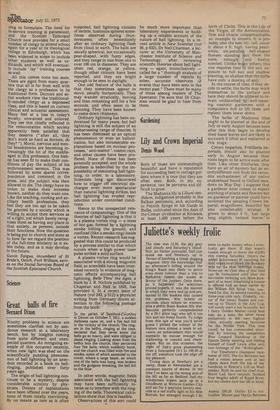Science
Great balls of fire
Bernard Dixon
Knotty problems in science are sometimes clarified not by assiduous research at a laboratory bench, but by insights coming from quite different and unexpected quarters. An intriguing example of this occurred recently, when new light was shed on the scientifically puzzling phenomenon of ball lightning by an anecdote recorded in a book on bellringing, published over forty years ago.
The origin of ball lightning continues to be a mystery, despite considerable scrutiny by physicists. Dozens of explanations have been offered over the years, none of them totally convincing. By no means as rare as is often supposed, ball lightning consists of mobile, luminous spheres sometimes observed during thunderstorms, often immediately after an ordinary lightning flash from cloud to earth. The balls are usually spherical, but occasionally pear-shaped, with fuzzy edges, and they range in size from one to over 100 cm in diameter. They are often red, orange, or yellow, though other colours have been reported, and they are bright enough to be seen in daylight.
One odd feature of the balls is that they sometimes appear to move, usually horizontally. They may wander erratically, moving and then remaining still for a few seconds, and often seem to be spinning. They have been known to come down chimneys.
Ordinary lightning has been understood for many years, but ball lightning is still the subject of an embarrassing range of theories. It has been dismissed as an optical phenomenon or even an hallucination, but also innumerable explanations based on nuclear processes, anti-matter ', cosmic rays, and other causes have been proffered. None of these has been generally accepted, and the whole problem is bedevilled by the impossibility of simulating ball lightning, to order, in a laboratory. Scientists long ago discovered how to trigger off electrical discharges even more spectacular than natural lightning strikes, but ball lightning has evaded reproduction under controlled conditions.
Hence to the unexpected relevance of campanology. One of the theories of ball lightning is that it is a plasma vortex ring — a mass of hot gas, formed by a lightning stroke hitting the ground, and confined (like a smoke ring) inside a vortex. Recent research has suggested that this could be produced by a process similar to that which occurs when a high power laser pulse strikes a solid surface.
A plasma vortex ring would be associated with a strong magnetic field, so scientists have been interested recently in evidence of magnetic effects accompanying ball lightning. Bells Thro' the Ages, a book by J. R. Nichols published by Chapman and Hall in 1928, has provided it. In a recent issue of Nature (vol 243, p 512) a physicist writing from Germany draws attention to the following passage from the book:
In the parish of "Samford-C.Ourthey in Devon on October 7, 1811, a sudden darkness came on, and a fire ball fell in the vicinity of the church. The ringers in the belfry, ringing at the time, declared that they never knew the bells go so heavy, and were obliged to desist ringing. Looking down from the belfry into the church, they perceived four fire balls, which suddenly burst, and the church was filled with fire and smoke, some of which ascended to the tower, where a large beam, on which one of the bells was hung, was broken and the gudgeon breaking, the bell fell to the floor.
In other words, magnetic fields associated with the ball lightning may have been sufficiently intense as to interfere with the ringing of the bells. Theoretical calculations show that this is feasible.
Observations of this sort could be much more important than laboratory experiments in building up a reliable account of the nature of ball lightning. In a recent article in New Scientist (vol 56, p 632), Dr Neil Charman, a lecturer at the University of Manchester Institute of Science and Technology, after reviewing scientific theories about ball lightning — again, inconclusively — called for a "thorough analysis of a large number of reports by sober, accurate observers of events that have been seen in the recent past." There must be many of those among readers of The Spectator. I'm sure that Dr Charman would be glad to hear from them.






























 Previous page
Previous page